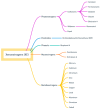The Influence of Environmental Exposure to Xenoestrogens on the Risk of Cancer Development
- PMID: 39596429
- PMCID: PMC11594813
- DOI: 10.3390/ijms252212363
The Influence of Environmental Exposure to Xenoestrogens on the Risk of Cancer Development
Abstract
Xenoestrogens (XEs) are a group of exogenous substances that may interfere with the functioning of the endocrine system. They may mimic the function of estrogens, and their sources are plants, water or dust, plastic, chemical agents, and some drugs. Thus, people are highly exposed to their actions. Together with the development of industry, the number of XEs in our environment increases. They interact directly with estrogen receptors, disrupting the transmission of cellular signals. It is proven that XEs exhibit clinical application in e.g., menopause hormone therapy, but some studies observed that intense exposure to XEs leads to the progression of various cancers. Moreover, these substances exhibit the ability to cross the placental barrier, therefore, prenatal exposure may disturb fetus development. Due to the wide range of effects resulting from the biological activity of these substances, there is a need for this knowledge to be systematized. This review aims to comprehensively assess the environmental sources of XEs and their role in increasing cancer risk, focusing on current evidence of their biological and pathological impacts.
Keywords: environmental exposure; estrogens; isoflavones; pesticides; xenoestrogens.
Conflict of interest statement
The authors declare no conflicts of interest.
Figures


Similar articles
-
Combinations of physiologic estrogens with xenoestrogens alter ERK phosphorylation profiles in rat pituitary cells.Environ Health Perspect. 2011 Jan;119(1):104-12. doi: 10.1289/ehp.1002512. Epub 2010 Sep 22. Environ Health Perspect. 2011. PMID: 20870566 Free PMC article.
-
The role and impact of estrogens and xenoestrogen on the development of cervical cancer.Biomed Pharmacother. 2016 Dec;84:1945-1953. doi: 10.1016/j.biopha.2016.11.007. Epub 2016 Nov 15. Biomed Pharmacother. 2016. PMID: 27863841 Review.
-
In Vitro and Vivo Identification, Metabolism and Action of Xenoestrogens: An Overview.Int J Mol Sci. 2021 Apr 13;22(8):4013. doi: 10.3390/ijms22084013. Int J Mol Sci. 2021. PMID: 33924608 Free PMC article. Review.
-
Pharmaco- and toxicokinetics of selected exogenous and endogenous estrogens: a review of the data and identification of knowledge gaps.Crit Rev Toxicol. 2014 Sep;44(8):696-724. doi: 10.3109/10408444.2014.930813. Epub 2014 Aug 6. Crit Rev Toxicol. 2014. PMID: 25099693 Review.
-
[Xenoestrogens: endocrine disrupting compounds].Ginekol Pol. 2008 Nov;79(11):785-90. Ginekol Pol. 2008. PMID: 19140503 Review. Polish.
Cited by
-
Epigenetic Mechanisms of Endocrine-Disrupting Chemicals in Breast Cancer and Their Impact on Dietary Intake.J Xenobiot. 2024 Dec 24;15(1):1. doi: 10.3390/jox15010001. J Xenobiot. 2024. PMID: 39846533 Free PMC article. Review.
-
Exogenous Estrogens as Breast Cancer Risk Factors: A Perspective.Cancers (Basel). 2025 Aug 18;17(16):2680. doi: 10.3390/cancers17162680. Cancers (Basel). 2025. PMID: 40867309 Free PMC article. Review.
References
-
- Woźniak M., Murias M. Xenoestrogens: Endocrine Disrupting Compounds. Ginekol. Pol. 2008;79:785–790. - PubMed
Publication types
MeSH terms
Substances
Grants and funding
LinkOut - more resources
Full Text Sources
Medical

